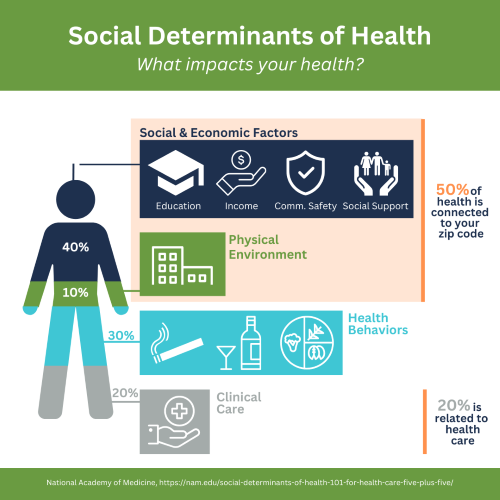Health Equity
The role of public health is to address the health of the whole community, for all people. The term “health equity” means that all people have a fair chance to live the most healthy life that they can (APHA, 2023). Healthy people are key to a strong nation (Robert Wood Johnson Foundation, 2023). The Scott County Health Department provides services that support good health and health equity in our community.
Doing what you can to be healthy is important. Yet, health is also greatly affected by things outside of a person’s control. In fact, as shown in the image below, 50% of health is based simply on where a person lives.

Social Determinants of Health (SDOH) are the conditions in the places where people live, learn, work, and play that affect a wide range of health and quality-of life-risks and outcomes. The five key areas of SDOH include (CDC & Healthy People 2030):
- Economic Stability – Having a steady income can help people to afford things like healthy foods and housing.
- Education Access and Quality – Having education opportunities can lead to higher-paying and safer jobs.
- Health Care Access and Quality – Having health insurance helps people to have a regular doctor. They can also get the health care and medications that they need.
- Neighborhood and Built Environment – Having a safe place to live, walk, and bike helps improve health and quality of life.
- Social and Community Context – Having positive relationships at home, work, and in the community can help promote positive health.
SDOH impact people's health and quality of life. Unfortunately, SDOH are not experienced the same way by everyone. For example, a person who has job experience and a reliable way to get to work may have more job opportunities. Or a person who lives close to a grocery store will have healthier food choices than someone who does not. The choices people make are limited by the choices they have.
We expect some health differences/disparities to occur naturally, such as women being diagnosed with breast cancer more often than men. Yet there are also health inequities, or differences in people's health status, that are not due to natural or biological causes. For example, Black or African American women are more likely to die from breast cancer than white women (National Library of Medicine, 2020). Another example is that the average life expectancy (age that most people live to) of Black or African American people in the U.S. is four years lower than that of white people (CDC, 2023).
These health gaps are often seen in groups of people that have been made vulnerable because of their race, religion, social class, gender, age, sexual orientation, physical ability, and other traits. As a result, people in some racial and ethnic groups have higher rates of health issues (like high blood sugar, obesity, lung illness, cancer, etc.) than others. While it takes focused effort, it is possible to improve health inequities, so that all people have a fair chance to live the most healthy life that they can.

It is key that public health supports equity. SCHD works to help people get a fair chance to reach total health and well-being. Learn more about SCHD’s Health Equity Work.
To find out even more about health equity, visit our Health Equity Resources page.

